 Einleitung
Einleitung  Einleitung
Einleitung
The Hartmann von Knowledge Base Portal !!!!
A more complete introduction to the following was written by Prof. Roy A. Boggs to honor Prof. Norbert Wolf: "Quo Vadimus: Sharing Data in a Very Large Arena", in: Korpuslinguistik deutsch: synchron – diachron - kontrastiv, ed. by Johannes Schwitalla and Werner Wegstein, Tübingen: Niemeyer, 2005, pp. 311 - 318.
General Format

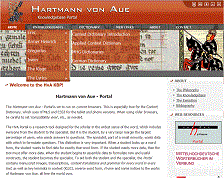
The Hartmann von Aue (HvA) Knowledge Base Portal is organized around two sets of web pages: one set for each of the poet's works, including the lyrics. These are presented in the following order: Erec, Armer Heinrich, Gregorius, Iwein, the Lament and the lyrics. The second set of web pages includes the HvA Context Dictionary.This contains context dictionary entires for each lemma, along with translations in German and English with context for each word in Hartmann's texts. [ Select 'Dictionary' on the Menu above.] The HvA home page (v. image above) also includes links to introductory pages, a bibliographyof materials used, and a link to the valuable Internet Middle High German dictionary projects (BMZ, Lexer, the Findebuch, and (new) Middle High German Dictionary) at the Kompetenzzentrum at the University of Trier, prepared under the direction of Professor Kurt Gärtner.
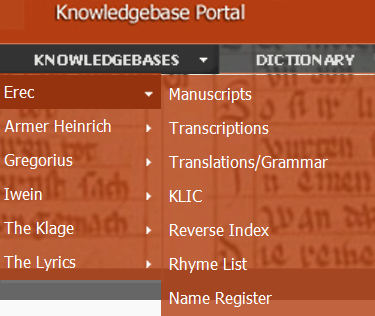 For each work, draft web pages are available in the progression (v. image left): manuscript(s), transcription(s), context equivalents with grammar for each word , key-lemma-in-context (KLIC) entries, reverse index, rhyme list, and name register.
For each work, draft web pages are available in the progression (v. image left): manuscript(s), transcription(s), context equivalents with grammar for each word , key-lemma-in-context (KLIC) entries, reverse index, rhyme list, and name register.
Students, along with their mentors, at various universities (such as Bonn, Florida Gulf Coast, Trier and Würzburg) have assembled and continue to assemble these data as an excellent pedagogical exercise and as a contribution to scholarship. So far, students from over seventeen countries have become involved. And, there is room for more.
The long-range purpose of the Hartmann von Aue Portal is to assemble and present in an appropriate manner supporting materials for philological and literary research. Because it is at the same time a research project in the application of Information Technologies to research in the Humanities, there will ever be new and interesting opportunities as better and more sophisticated hard- and software applications are developed. There were be opportunities to update and expand the various datasets as more and more scholars access the routines that retrieve, format and display subsets of the data. In this sense, the portal itself will never be completely finished. It is therefore to be used as it is and improved whenever and wherever possible.
Because these materials constitute a knowledge base, they represent a starting point. They are never an end in themselves. Rather, they are the beginning of the journey. They are resources and they must be regarded as such. The philosophical structure is given elsewhere on this web site. The basic tenet is, beginning with the critical edition, look for any word form under 'context eqivalents/grammar'(they are all there!), look in the concordance(s) to see where else this word form is used and in what context, check the context dictionary, see how the word form is used in conjunction with other word forms. Once the word form is understood in this work, look at HvA's other works, and then look at BMZ and Lexer. (The Grimm dictionary is also available on line.) In other words, start from the bottom and work up. Learn to use these materials wisely and they will lead you to a whole new world.
The Manuscripts: ad fontes
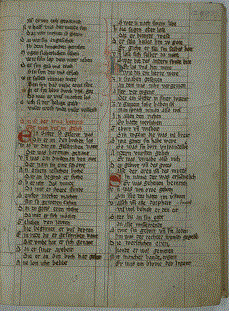 The excellent digitized manuscripts images assembled so far have been made available through the generosity of several major libraries. They have willingly provided the images not only as a contribution toward expanding scholarly opportunities but because seeing is indeed believing. There is a reason why they treasure and protect these manuscripts for all of us; and it all becomes real when ones sees it for what it is - the heritage of human endeavor and excellence.
The excellent digitized manuscripts images assembled so far have been made available through the generosity of several major libraries. They have willingly provided the images not only as a contribution toward expanding scholarly opportunities but because seeing is indeed believing. There is a reason why they treasure and protect these manuscripts for all of us; and it all becomes real when ones sees it for what it is - the heritage of human endeavor and excellence.
Our manuscripts are also the source from which everything is developed. And one must continually return to the manuscripts: ad fontes. They are the source of it all.
The majority of the images presented here are offered in two forms: a 'normal' format and an enlarged format. The normal format makes excellent viewing and provides an excellent flavor of the manuscript and a feel for the scribe. The enlarged format, if one is patient in downloading the image, can often prove extremely rewarding. One sometimes finds things not otherwise visible – perhaps even when one looks at the actual manuscript itself. Look at Armer Heinrich manuscript Ba249r and note that in order to later add a title, someone found it necessary to scrape off previous rows of text and rewrite them higher on the pages; or, look about two-thirds down in the second column and find 'in dubio' entered interlineally. It doesn't come much better than this.
If reference is made to one of the manuscript pages, be sure to footnote the holding library. This is only honest and fair. Also, as with some of the Iwein A pages, they can be digitized and enlarged, but one cannot put back something that has be destroyed. Look at Armer Heinrich C to discover what happens when someone unwisely handles a manuscript page. Here a regent was used in the hope that it would make the text clearer, and it eventually ate part of the page itself.
Until recently, these images were not available in such a wonderful format. Appreciate the images, use them for scholarship, and remember the libraries that protect them for us and our heirs.
The Transcriptions
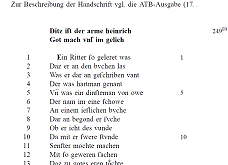 The next step up from the manuscript is the transcription. Excellent transcriptions are not easy to find, but they are extremely important. They are the bridge between the manuscript and all other scholarly activities, including critical editions. Prof. Kurt Gärtner has graciously provided transcriptions for all of the Armer Heinrich manuscripts. These should be viewed carefully and compared to the manuscripts themselves. Historically important transcriptions for the Codex Manessa from Pfaff and Salwosky are also available. Dr. Evelyn Meyer of St. Louis University has prepared an excellent transcription to Iwein A. These are instructive and represent material not often seen.
The next step up from the manuscript is the transcription. Excellent transcriptions are not easy to find, but they are extremely important. They are the bridge between the manuscript and all other scholarly activities, including critical editions. Prof. Kurt Gärtner has graciously provided transcriptions for all of the Armer Heinrich manuscripts. These should be viewed carefully and compared to the manuscripts themselves. Historically important transcriptions for the Codex Manessa from Pfaff and Salwosky are also available. Dr. Evelyn Meyer of St. Louis University has prepared an excellent transcription to Iwein A. These are instructive and represent material not often seen.
The transcriptions are also extremely valuable because they are in *.pdf format and can be searched. Lexical items not in the critical edition can be extracted and combined to generate the bases for interesting scholarly activity. Data once limited to only a few can be made available for students and scholars, and the list of possible valuable projects has yet to be even hinted at.
The Context Equivalents/Grammar
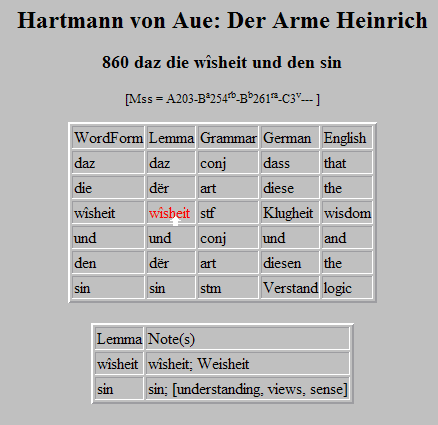 The context equivalents/grammar pages represent the most extensive volume of data for the HvA Knowledge Base. When verse numbers are entered, the data are retrieved from data bases and formatted for presentation. The first line presents the verse as it is found in the most recent critical edition. Under this, when there are multiple manuscripts, is a list of the manuscripts in which this verse is found. Where there is a large number of manuscripts, as with the Iwein or the Gregorius, only the manuscripts currently in the Portal are referenced.
The context equivalents/grammar pages represent the most extensive volume of data for the HvA Knowledge Base. When verse numbers are entered, the data are retrieved from data bases and formatted for presentation. The first line presents the verse as it is found in the most recent critical edition. Under this, when there are multiple manuscripts, is a list of the manuscripts in which this verse is found. Where there is a large number of manuscripts, as with the Iwein or the Gregorius, only the manuscripts currently in the Portal are referenced.
Next is a table with the word forms found in the verse. Each is identified by a word form, a lemma, a grammatical form, and a German and an English equivalent. If one moves the cursor over a lemma, the lemma will be highlighted; and by clicking on the lemma, a link is provided to the corresponding entry in the Lexer MHG Dictionary, with further links to BMZ and the Findebuch, in Trier, Below this is, where applicable, a table of notes. These are not translations as such; they are equivalents in context. Actual poetic translations are often better represented in the various translations into German and English listed in the bibliography. Although here too one must be careful as many translations, especially into English but also in German, are translations of translations of translations from older, out-of-date editions and are not to be trusted. The Portal represents a knowledge base and it is intended to be current and to be used with other resources.
This aspect of the HvA Knowledge Base Portal can be the most dangerous if misunderstood. Because the material is presented in draft form and because it is presented as it is developed in its various stages, the data themselves must be used wisely. This represents an enormous undertaking and only after years will it be complete. Caution is taken to be as accurate as possible; and the various datasets will eventually be taken through several stages, from the initial draft, to a second rendering, to a check by an expert in Middle High German philology. This is the approach to building a knowledge base. Each step is useful in its context, but the actual data warehouse will not be fully stocked in the beginning. Be forewarned!
The Concordance: Key Lemma In Context (KLIC)
 The Key Lemma In Context (KLIC) concordance is generated automatically whenever a request is submitted. Along with the current verse, the preceding and succeeding verses are presented, along with grammar, German and English equivalents. The KLIC index differs from a KWIC (Word) index in that the dataset is already fully lemmatized; and since the dataset contains far more information than a simple KWIC index, a KLIC index is much more valuable and can be generated just as quickly. Of all the tools on the HvA Portal, the KLIC index may eventually prove the most accessed.
The Key Lemma In Context (KLIC) concordance is generated automatically whenever a request is submitted. Along with the current verse, the preceding and succeeding verses are presented, along with grammar, German and English equivalents. The KLIC index differs from a KWIC (Word) index in that the dataset is already fully lemmatized; and since the dataset contains far more information than a simple KWIC index, a KLIC index is much more valuable and can be generated just as quickly. Of all the tools on the HvA Portal, the KLIC index may eventually prove the most accessed.
The Reverse (Wordform) List
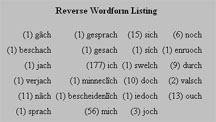 The Reverse wordform listing is also generated automatically from the database. It is ordered from top to bottom in a table, beginning with the left most column. The number of occurrences are also given. Web pages are displayed in alphabetic units. A quick search of a list can provide an insight into the location of common grammatical features. The example here is from the lyrics for the letter 'h'.
The Reverse wordform listing is also generated automatically from the database. It is ordered from top to bottom in a table, beginning with the left most column. The number of occurrences are also given. Web pages are displayed in alphabetic units. A quick search of a list can provide an insight into the location of common grammatical features. The example here is from the lyrics for the letter 'h'.
The Rhyme Listing
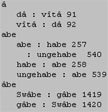 The rhyme listings appear different for different works. For those with pair rhymes, the format shown here will be built and displayed. For the lyrics and the Lament, slightly different formats are created. Even though different scripted algorisms are used, the data themselves are complete. Taken together they provide a useful clue to pronunciation and rhyming practices. They are sorted according to accepted philological practices.
The rhyme listings appear different for different works. For those with pair rhymes, the format shown here will be built and displayed. For the lyrics and the Lament, slightly different formats are created. Even though different scripted algorisms are used, the data themselves are complete. Taken together they provide a useful clue to pronunciation and rhyming practices. They are sorted according to accepted philological practices.
The Name Register
 The name register is simple in concept. It retrieves the proper names from the database, sorts them, and presents them in a table with their occurrences. .
The name register is simple in concept. It retrieves the proper names from the database, sorts them, and presents them in a table with their occurrences. .
Future Projects and Expansion
A knowledge base can contain other materials along with datasets and manuscript images. Three of these are given below as an indication of what might be done: audio presentations of textual material, images depicting medieval life, or simply links to older research not often referenced but valuable nonetheless. The list of what might be added here is almost endless.- Audio: The menu for the Arme Heinrich contains a link to an audio reading of the first set of verses. It is included just to show what might be done. There are, of course, professional presentations of the Arme Heinrich and one of them might sometime be appropriately included in the Portal.
- Images: There is always much interest in exactly what the medieval world looked like. References in a text to items such as dress, style, architecture, animals, armor parts, or trappings are in themselves interesting, worthy of investigation and inclusion in the Portal. Even an image of something as simple as the reference in Er 7502 to the 'hagenbüechîn' (Heinbuchenholz, hard wood) can prove worthwhile.

- Older Literature: As an example, an offprint from an article by Walter Röll is included in the bibliography: Zu den Benediktbeurer Bruchstücken des ‘Armen Heinrich’ und zu seiner indirekten Überlieferung, ZfdA 99 187-199. View Offprint It would be possible over a period of time to add a significant set of such references to the Portal.
As is stated above, the long-range purpose of the Hartmann von Aue Portal is to assemble and present in an appropriate manner supporting materials for philological and literary research. Because it is at the same time a research project in the application of Information Technologies to research in the Humanities, there will ever be new and interesting opportunities as better and more sophisticated hard- and software applications are developed. There were be opportunities to update and expand the various datasets as more and more scholars access the routines that retrieve, format and display subsets of the data. In this sense, the portal itself will never be completely finished. It is therefore to be used as it is and improved whenever and wherever possible. The HvA Portal is there to be used freely by whomever, wherever and whenever. Be sure to enjoy it and thank those who have contributed to it!





